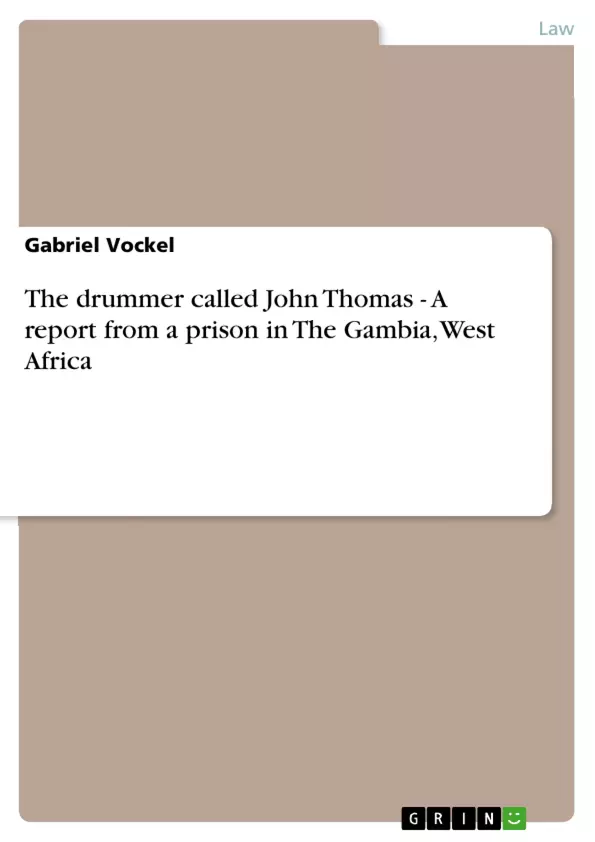As we walked a few more steps forward we came across three wardens, who opened another iron gate for us, while greeting us with the common African cheerful
handshakes. In the main yard that lay in front there was a roughly tarred football field on which a handful of prisoners were kicking around with an old football. There were about 50 more prisoners sitting in circles against the walls of the fence around the field. They were chatting and laughing in an atmosphere portentous of a market or café rather than a prison. Our sudden appearance on the scene brought the conversation to a pause in some of the groups. They watched us curiously, but in a friendly manner and I was naturally a curiosity for them as a result of my white colour. As the ball was kicked towards the goal it hit me on the leg. The guy who had kicked it came running towards me with apologies. The metal board that was on the left side of the wall bore the number “291”, written in chalk. The current number of inmates. The guys who were closer to me came over to shake my hands, and to express their gratitude for my visit. A bit out of the circles there sat a gentleman of about 40. His hair was being shaved by another prisoner with a simple razor blade. The fact that a warden was standing by and having small talk with them did seem to suggest that it was not forbidden to have a razor blade here.
At the left side of the courtyard there was a small building with glassless window frames. We made our way into it. The walls were painted dark-green. In the front part of the room there was a big blackboard on which there was some faded writing, probably in Mandinka or Wolof, two of the local languages spoken around here. There was also an orderly row of benches and chairs, which in combination with the nature of the entire space gave the impression of a normal classroom. Apart from our ‘Outsider Group’ there were a handful of prisoners in the room. All the prisoners present here, and who were seemingly already good friends to the rest of the outsider group, greeted me very warmly. We took our seats, and Alex uttered some greetings, which were translated into Wolof for the sake of those who could not understand the language of the Commonwealth.
Inhaltsverzeichnis (Table of Contents)
- The Drummer Called John Thomas
- Arrival and First Impressions
- Meeting the Inmates and Observing the Daily Routine
- The Religious Service and its Impact on the Inmates
- John Thomas: A Man of Faith and Hope
- Departure and Reflections
Zielsetzung und Themenschwerpunkte (Objectives and Key Themes)
This report aims to provide a personal account of a visit to a prison in The Gambia, highlighting the experiences and observations of the author, a UNICEF legal consultant. It captures the atmosphere, the routines, and the hopes of the inmates, focusing on the influence of faith and music on their lives.
- The power of faith and hope in the face of adversity
- The role of music and ritual in shaping prison life
- The impact of incarceration on the human spirit
- The importance of human connection and empathy in a restrictive environment
- The search for meaning and purpose within the confines of imprisonment
Zusammenfassung der Kapitel (Chapter Summaries)
- The Drummer Called John Thomas: This introductory chapter sets the scene by describing the author's arrival in Banjul, The Gambia, and his subsequent visit to the central prison. It introduces the context and the main characters involved in the report.
- Arrival and First Impressions: This chapter details the author's initial impressions of the prison environment, describing the physical layout, the security measures, and the presence of guards and prisoners. The author observes the daily routines and interactions between the inmates.
- Meeting the Inmates and Observing the Daily Routine: This chapter focuses on the author's encounters with the inmates, noting their diverse backgrounds and the impact of imprisonment on their lives. It describes the atmosphere within the prison, which is surprisingly upbeat and characterized by music and camaraderie.
- The Religious Service and its Impact on the Inmates: This chapter recounts the author's participation in a religious service led by a Gambian priest and a Sierra Leonean volunteer. It describes the significance of faith and hope for the inmates, and the role of music and hymns in their spiritual practice.
- John Thomas: A Man of Faith and Hope: This chapter focuses on the powerful figure of John Thomas, the drummer, who embodies resilience and hope. It explores his story, his sentence, and his aspirations for the future.
Schlüsselwörter (Keywords)
The key concepts explored in this report include imprisonment, faith, hope, music, human connection, resilience, and the search for meaning. The report highlights the influence of faith and music on the lives of prisoners in The Gambia, demonstrating their ability to provide solace, purpose, and strength in a challenging environment.
- Citation du texte
- Master of Arts in Diplomacy, Law and Global Change Gabriel Vockel (Auteur), 2002, The drummer called John Thomas - A report from a prison in The Gambia, West Africa, Munich, GRIN Verlag, https://www.grin.com/document/66219



